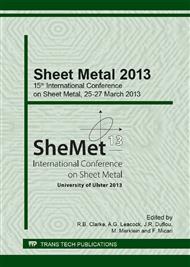p.277
p.284
p.295
p.302
p.311
p.317
p.325
p.333
p.340
Mechanical Response of Ti-6Al-4V Alloy on Deformation at Moderate Temperatures
Abstract:
Due to beneficial characteristics such as high specific strength, corrosion resistance and biocompatibility Ti-6Al-4V alloy has become the most important industrially produced titanium alloy during the last decades. Commonly used for aerospace technology and medical products, nowadays Ti-6Al-4V covers 50% of the worldwide produced titanium alloy parts. Different deformation operations as forging and casting as well as machining are used to shape titanium alloy components. For sheet metals, cost and time of fabrication can be reduced significantly via the near net shape technology sheet metal forming. Materials such as the α + β alloy Ti-6Al-4V with high yield stress and comparatively low elastic modules need to be formed at elevated temperatures to increase their formability. Numerical simulations are applied to calculate the forming behavior during the process and conclude the characteristics of the shaped part. Therefore in this paper the mechanical behavior of this titanium alloy is investigated by uniaxial tensile test within elevated temperatures ranging from 250 to 500 °C. Finally, the experimental results are adapted to models which predict the flow response in order to describe material behavior in finite element analysis of the forming process.
Info:
Periodical:
Pages:
311-316
Citation:
Online since:
April 2013
Authors:
Price:
Сopyright:
© 2013 Trans Tech Publications Ltd. All Rights Reserved
Share:
Citation:


